How to prevent parasites from feasting on your poultry and eggs
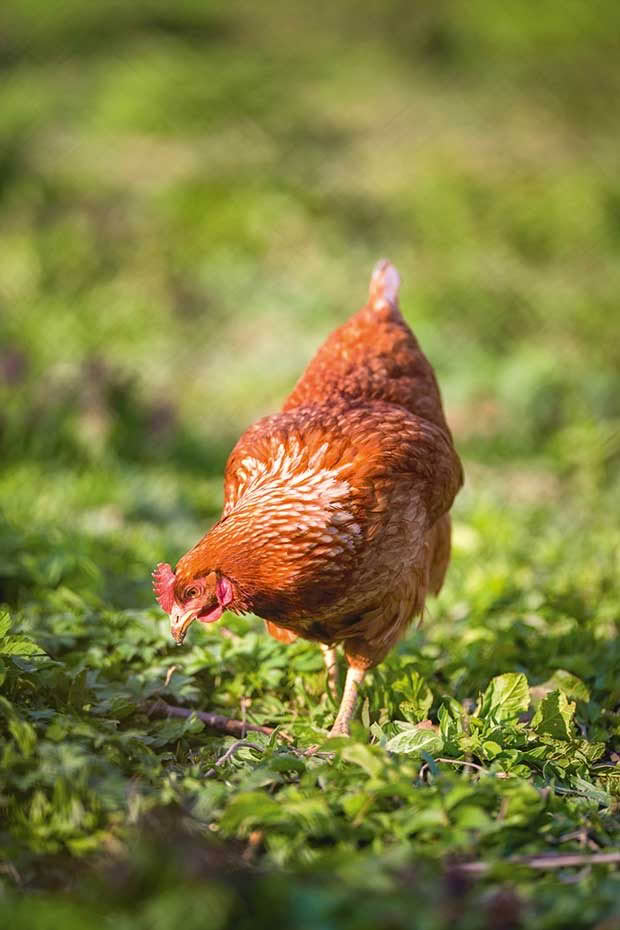
We look at the insects that can have population explosions in your hen house over summer.
Words: Sue Clarke
Summer is often a time when there is an explosion of mites, lice and fleas in your flock, so it pays to be vigilant and take action before the problem gets out of hand and causes problems, especially among your vulnerable new chicks.
A parasite is a living organism that lives solely off another living organism without providing any benefits to its host and often causing debilitating problems. Parasites can be divided into internal and external parasites.
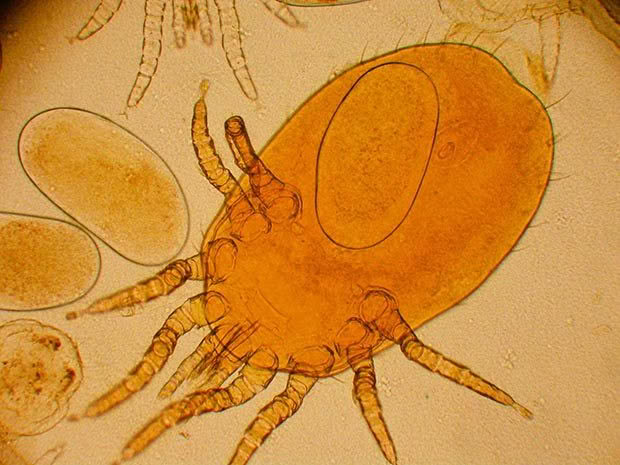
The ones that affect poultry in New Zealand can range from simple protozoa, which are single-celled microscopic organisms that cause diseases like coccidiosis, to the various worm species which affect different parts of the birds anatomy, to the insect pests, including red mite, scaly leg mite, lice and fleas.
EXTERNAL PARASITES: RED MITE
Dermanyssus gallinae
Identification: very small (1mm x 0.4mm) or about the size of a speck of dirt or a pin head when full of blood. Empty mites look like a smear of grey ash around the cracks between surfaces and where perches meet the supports. Specks of blood on the eggs can indicate red mite are present in the nests.
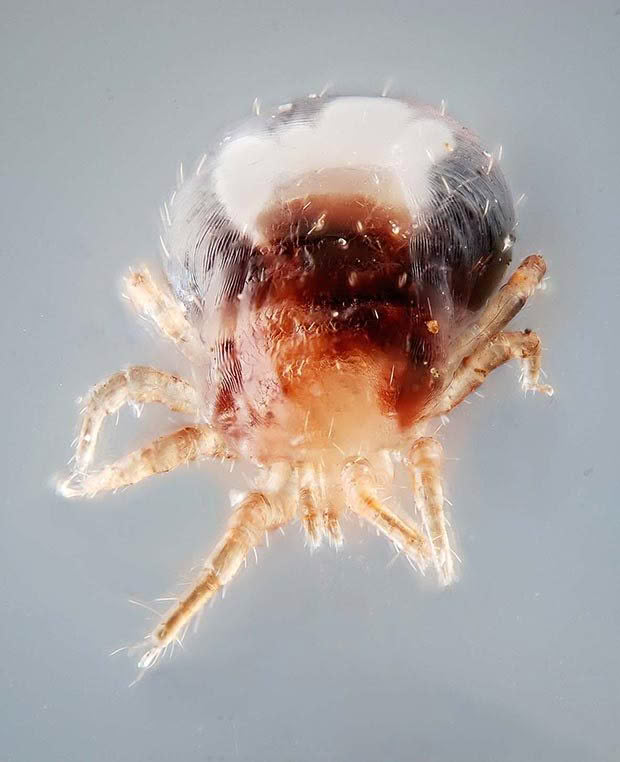
Red mite: Dermanyssus gallinae.
Where do you find them: only go on the bird at night to feed, rarely seen during the day unless the bird is ill or broody. Lives in the crevices of the roosting and nesting area by day.
Life cycle: the eggs can remain dormant for long periods, up to several months, without birds being present (and can be viable for two years), while hatched mites can go up to six months between feeds. The life cycle from hatching to egg laying takes less than a week and one female can lay up to 120,000 eggs.
Effect: red mite is probably one of the most common parasites and very hard to eliminate. It causes irritation and restlessness in the birds. Moderate infestations can cause anaemia which can result in a drop in egg production, a reluctance of birds to use the nests and roosts within the coop, and can lead to more severe anaemia and death of young chicks or broody hens on the nest.
Mites can also act as vectors of other disease organisms like salmonella, fowl typhoid and fowl cholera between birds. Humans can also be bitten and some may be allergic to their presence. At the very least they will often cause an irritation by crawling over your skin.
Treatment: hot summer weather can result in a mite population explosion so be prepared to treat more frequently in summer. Mites live in the nesting and roosting areas, and are very adept at getting into the smallest crevices which makes control quite difficult. The main method should be spraying the house regularly with a product effective on mites. Some of these are of limited use on livestock animals used for food production.
Products to try:
• Neem oil (20% solution in water)
• Ripcord Plus (70ml/ltr water)
• Pour-on cattle treatments containing Ivermectin can be used ‘off label’ under the direction of a vet on the birds themselves. It is primarily used to treat for internal parasites like worms but is also useful on ectoparasites like red mites and fleas which feed on blood. It is not as effective at killing off lice which feed on skin and feather debris. Repeated treatments on all birds is recommended at regular intervals to effect control of hatching mites, so probably not feasible long-term, especially with young chicks.
Alternatives:
Some research has been done on various plant-derived essential oils, notably cinnamon, coriander, pennyroyal, spearmint, mustard, and garlic with some success. A garlic-based product is available commercially in UK.
The use of diatomaceous earth (DE) is not as effective as it cannot be inserted readily into the crevices where the mites live most of the time, but it does work as a dessicant on the mites’ outer shell when it comes into contact with the dust.
References:
• www.ncl.ac.uk/afrd/assets/documents/PRMdocument1.pdf
• www.basf.co.nz/products/insecticides/ripcord-plus.aspx
NORTHERN FOWL MITE
Ornithonyssus sylviarum
Identification: these are much the same size as the red mite but are black or red in colour, and distinguished by their presence on birds during the day, especially in concentrated areas. This blood-sucking mite lives on the birds day and night, and is usually concentrated around the tail and vent area. It can often be seen as a marked area of cracked and bloody scabs around the vent, under the wings and sometimes in the skin of the crest on the head of birds which have crest. Its eggs (which are white) can be seen in clumps attached to the fluff at the base of feathers.
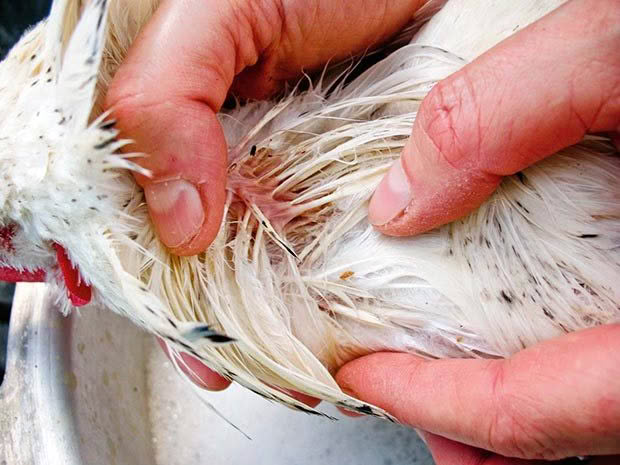
Northern fowl mites.
Life cycle: the life cycle is 7 days or less from hatching to egg laying. Adults can only survive 2-3 weeks without feeding so removal of birds from an infested house for at least three weeks will control mite outbreaks. However, do not restock with birds which are already infested! Remember these mites affect wild birds too, so sparrows and other birds which frequent poultry environments are often a source of reinfestation.
Effect: apart from the similar irritation and anaemia as for red mite, northern fowl mite is more likely to bite humans and can cause red raised skin and intense itching.
Treatment: use an insecticide on the bird, an insecticide spray in the coop, DE (diatomaceous earth) sprinkled in their dust bathing area could also be of use on these mites.
Reference: http://anrcatalog.ucdavis.edu/pdf/8162.pdf
SCALY LEG MITE
Knemidocoptes mutans
This is probably the most common external parasite after red mite in NZ. It is a very small, microscopic mite with an oval body and short legs which lives under the skin and spends its life in the unfeathered parts of the body, notably the legs and feet, but sometimes around the beak and nostrils.
Identification: due to it being microscopic and also spending its entire life below the skin or scales of the leg, often the only sign of an infestation will be a flaky or powdery appearance on the legs.
Effect: the disruption of the surface of the legs/feet progresses into distorted scabs and lumps which can cripple the bird.
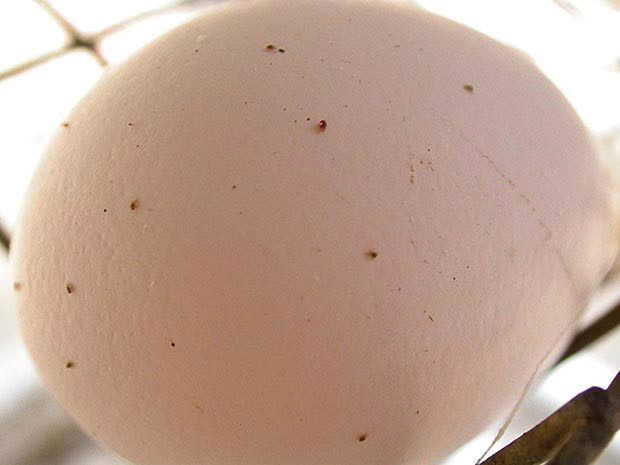
Northern Fowl mites on an egg. Photo: Professor Bradley Mullens University of California.
Treatment: the mites can be effectively killed by suffocation by covering the affected area with some form of grease or oil. A petroleum gel like Vaseline® on its own, applied with an old toothbrush, will do the trick. Repeat application regularly (once a day for two weeks) as it gets rubbed off. A 50:50 mixture of kerosene and cooking oil will work as well.
Used engine oil was an old-fashioned cure but it’s pretty smelly and messy in comparison. Once the scales start to loosen they will lift off and these, together with the dead mites, can be removed by gently washing with warm soapy water before the next application of grease. The fresh new scales will develop below the distorted ones.
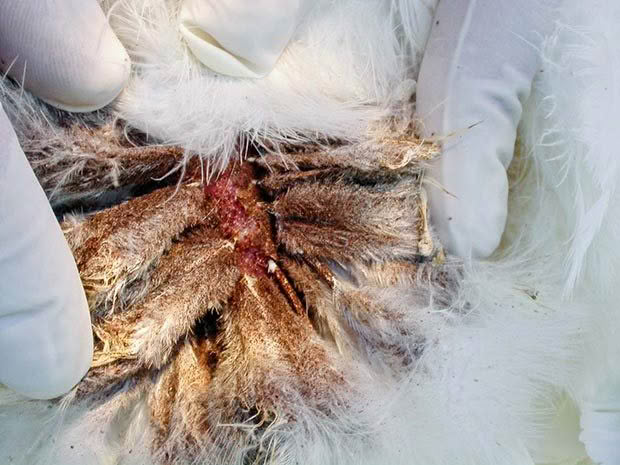
Clusters of northern fowl mite eggs on a hen. Photo: Professor Bradley Mullens University of California.
DEPLUMING MITE
Cnemidocoptes gallinae
Identification: very small mite (0.3mm) and hard to see as it burrows into the base of the feathers.
Effect: causes intense irritation to the skin, and birds often attempt to pull out their own feathers, giving them a ragged, tatty appearance
Treatment: Ivermectin pour-on – use 0.1ml per kg of body weight, dropped on the bird’s bare skin, preferably under the wing.
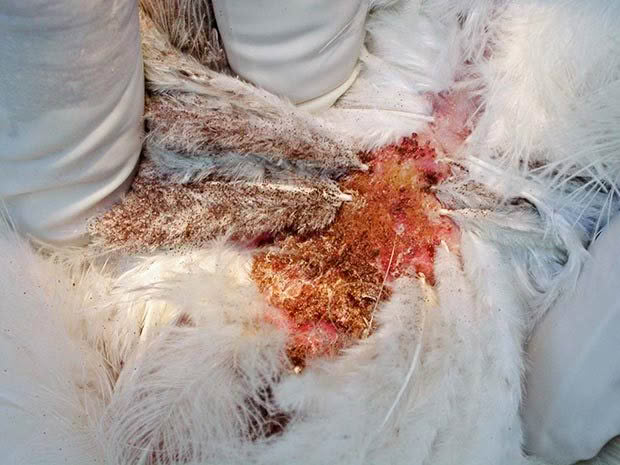
AIRSAC MITE
Cytodites nudis
Probably classed as an internal rather than external parasite, but being a mite it can be controlled by the Ivermectin pour-on as described for other mite control. While possibly hard to diagnose in a small flock situation, they can be a problem in aviary birds and passed on to poultry.
LICE
Goniodes gigas
There are several types of lice which can affect poultry but probably the large or brown chicken louse is the most common.
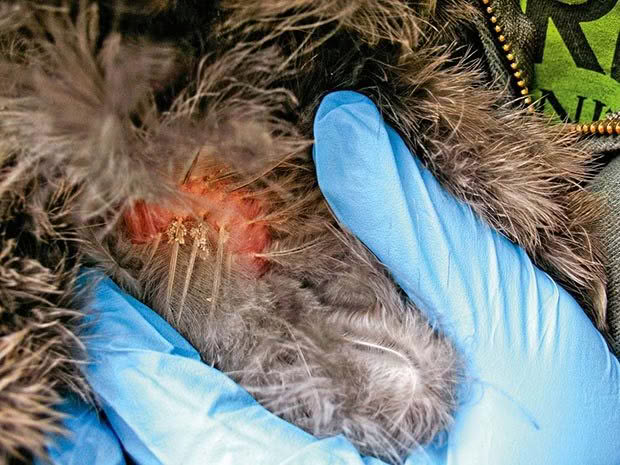
Lice eggs.
Life cycle: three weeks from hatching to egg laying. Adults can live for several months on the host but only a week off the bird without feeding. They are easily transferred from farm to farm by birds, used poultry equipment and wild birds.
Effect: Heavy infestation can cause a decrease in reproductive performance in roosters, reduced egg production in hens, and reduced weight gain in growing birds. The skin irritation they cause can also be a site for secondary bacterial infections.
Treatment: Dusting the birds with insect powder and providing a dust bathing area of diatomaceous earth will help in control. Spray any used equipment like buckets, feeders or nests with an insecticide before introducing them to your flock. Treatment will not kill louse eggs so repeat any individual bird treatment after 10 days.
FLEAS
There is a specific chicken flea, but the common cat/dog fleas are just as likely to be a problem where poultry and domestic animals live in the same environment.
Treatment: as for other insect pests. Individual dusting powder or Ivermectin pour-on will be useful. Treating the roosting and nesting area with one of the recommended insecticidal sprays is also recommended.
TICKS
There are specific types of poultry ticks (Argas persicus) but these are mainly restricted to tropical and subtropical countries. In NZ, birds are more likely to be affected by the ticks which affect cattle, deer and domestic animals. May attach themselves on the bare skin of the face. They also cause anaemia and weakness as with the other blood-sucking parasites.
Treatment: ensure you use a spray effective against ticks, such as Ripcord Plus. You will not be able to control the ticks in the free range environment, although it is said that Guinea fowl are good tick hunters. If you find any on your birds you can remove them using tweezers.
Tips:
• Mites build up resistance to certain products so if possible change the one you use from time to time.
• Use a sprayer to get into all the cracks in wooden frames, and underneath nests and perches. Thoroughly soak the area.
• Initially do two sprays a week apart and then monthly, more frequently in summer if needed.
• Sprays can be used with the birds present but it’s easier to shut them out of the coop for the day or until the surfaces are dry.
3 organic methods for parasite control
While not a perfect method for complete elimination of ectoparasites, especially when your birds have a severe infestation, some easily grown or obtainable natural products and oils can help to reduce parasite populations.
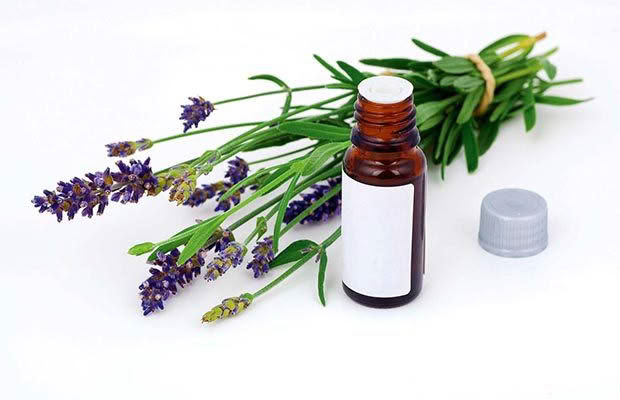
• Use dried herbs in nests and sprinkled throughout the coop litter. Sprigs of lavender, thyme, tansy and catnip may help repel fleas and lice.
• Combine 1 cup of cooking oil and 1 tbsp dishwashing liquid, shake vigorously to mix, then spray onto perches and into cracks and crevices in the woodwork of your hen house, several days in a row.
• Mix diatomaceous earth (food grade) in with nest litter, in dustbaths and dust along floors, perches and in as many crevices as you can reach. Use a dust mask while applying.
ESSENTIAL OIL SPRAYS FOR MITES
Sprays made up from the essential oils have been found to be effective, reducing mite numbers by 92% in 24 hours.
ESSENTIAL OIL SPRAY
• 225ml of water
• ½ tsp of essential oil (eg lavender, garlic, tea tree or thyme)
Mix up and spray on to birds weekly and also on to coop surfaces.
GARLIC JUICE SPRAY
• Fresh garlic cloves
• Water
Remove skins and crush in food processor until creamy. Push pulp through a fine sieve to create juice. Add 10ml juice to 100ml water. Spray directly onto the skin (around vent and under wings) weekly.

